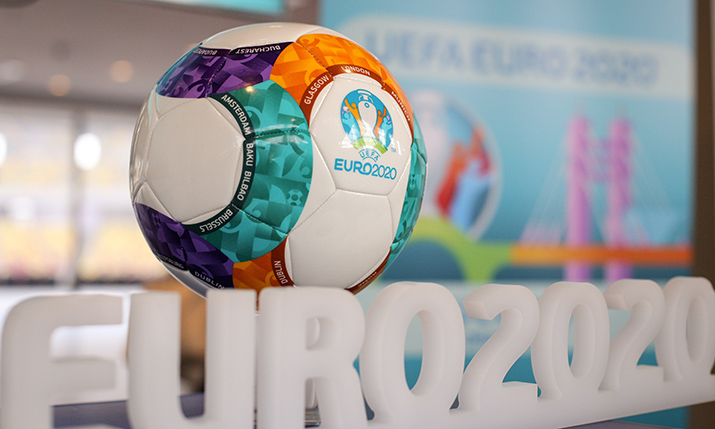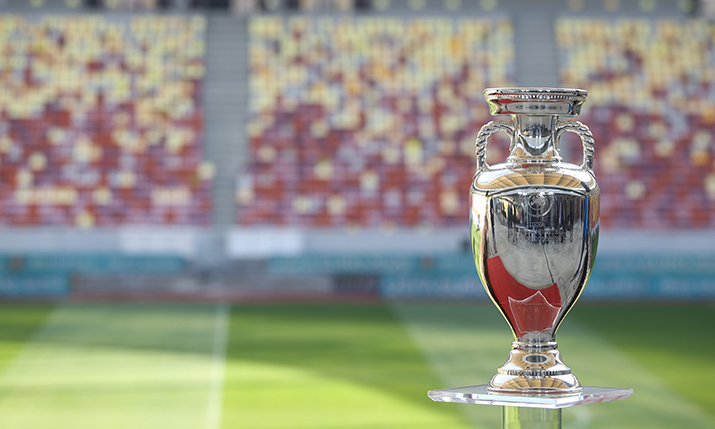Behind the sound: How UEFA has gone large with audio for Euro 2020
Host Broadcast Services continues to push into new audio territories

UEFA Euro 2020 was delayed because of COVID, but the rescheduled tournament has delivered all the quality, drama, upset, and elation that fans expected.
The audio for the European Football Championship has also delivered, bringing something special to the broadcast. The team behind the sound has continued to push into new territories, with everything from stereo to a fully immersive 9.1 mix available to broadcast partners.
Huge operation
As host broadcaster, UEFA provides a huge number of services to its broadcast partners around the world, and is constantly seeking new, engaging formats while pushing the technology envelope ever further.
The current 12 primary broadcast feeds consist of an international sound mix in stereo and 5.1 – with and without commentary – selected microphone splits and stems across the multifeeds and as part of the immersive audio package on the UHD feed, a full 9.1 mix plus an additional presentation tailored more for public viewing. English guide commentary can also be added to any of the above presentations.
“Our hearing doesn’t actually need any time difference information for height perception; we just need level difference”
HBS is one of the suppliers that is helping to fulfil UEFA’s mission for the tournament by supplying broadcast services for selected venues. The company is providing audio consultancy, MCR facilities, and is the company responsible for building the event IBC, situated at the Expo Haarlemmermeer, Vijfhuizen, in the Netherlands. HBS also supplies the commentary services for the event, which involves deploying over 620 commentary units (Lawo Commentary System) across all tournament venues.
Since 2016, the Europe-wide infrastructure has been based on AES67 IP transport across a dedicated UEFA European network with GPS synchronisation at the network ‘edges’ via Meinberg M1000 Grand Masters, which also deliver black and burst to all consumers at the venues.
Christian Gobbel, CTO at HBS, tells SVG Europe: “From 2006 we were using ATM for audio contribution. And even then, already had a 6,000 [squared] synchronous audio matrix across Germany. Now we have an 16,000 [squared] IP audio matrix across the whole of Europe.”
Each of the football venues are interconnected with the IBC by a fibre-based IP network that services all source contributors and consumers. The stadium microphones have three primary consumers: the main and back-up HB OB vehicles, and the IBC, which is where the immersive mix is created, amongst other contributions. There are two immersive studios (Lawo mc² 96 consoles) as the schedule overlaps many of the games.
The HB OB vehicles take care of the 5.1 and downmixed stereo feeds, while the immersive studios generate the 9.1 mix and additional objects for alternate presentations for the UHD broadcast.
 Sound in close up
Sound in close up
The IBC Immersive Audio studio takes all direct sources, including the main immersive microphone arrays and the individual feeds from the 20 pitch-side microphones which feed into the Lawo ‘Kick’ close-ball mixing system. There are also additional stems for some sources, where that makes sense.
“Some stems are pre-mixed at the venues, especially where they are dependent on either external sources or on the video cut,” explains Gobbel. “It wouldn’t make sense to transmit GPIs for the camera-mounted microphones, for example, so we get the signal pre-mixed into our audio-follow-video group. Other sources include all the replays and splits of the PA announcements, including a music premix as a stereo source.”
“Things like the opening ceremony music are all part of the drama; you can always hear the PA sounds though open mics anyway because the PA is so loud. It’s much better if people are immersed in a nice upmix of the music”
Although the Lawo Kick close-ball mix can use live tracking data from image analysis systems and provide a graphic showing the players, the ball, the microphone positions, and so on for the Euros, it was decided to take a more pragmatic approach and manually operate the Kick frontend at the IBC. Each microphone is mapped to a console channel, and the system produces a perfectly matching mix according to preferences and direction from the operator. This close ball feed is not only used for the 9.1 mix, but returned to the venue OBs for use in in the 5.1 and stereo mixes.
Felix Krückels, professor for broadcast and systems design at the University of Darmstadt, is immersive director for Euro 2020. He explains that for the 9.1 mix, the close ball sound is panned slightly to the height speakers: “It’s panned, I would say, 10% or 15% to the height speakers. It gives you a bigger impression of the ball kicks of the players, of the referee; whoever is close to these microphones.
“Previously, we’d get a lot of spill from close ball microphones with maybe 95% crowd noise and it would be rare to get the actual ball kick sound. You can get that spill down with different microphones and treatment, but still the problem is manually mixing it. Nobody mixing it could actually find the ideal crossfade point and the crowd spill would go up and down in the mix. Kick plays a huge role in a more precise close-ball mix.”
Immersive ORTF-3D microphone
Perfecting the main immersive microphone array for stadium sound has been a fascinating process for Euro 2020, and started with early experiments that added height-spaced ORTF arrays to push the 5.1 sound to 9.1. However, when Krückels approached Schoeps Mikrofone about putting this array in an ‘industrialised’ package, Schoeps’ technical director, Dr. Helmut Wittek, came back with an innovative design based on the research by Hyunkook Lee, associate professor in music technology at the University of Huddersfield, UK, and director of the centre for audio and psychoacoustic engineering.
“Our hearing doesn’t actually need any time difference information for height perception; we just need level difference,” explains Krückels. “The finished product uses supercardioid ORTF arrays very close together to achieve the levels difference required and we can clearly identify signals coming from the height layer and the main layer.”
This ORTF-3D microphone was active as a prototype as early as 2014. All UEFA Euro championship venues have been equipped with the finished array since 2018.
In 2019 Krückels experimented with spot microphones created from cardioid and figure of eight capsules, orientated to differentiate height rather than only left and right positions. This arrangement has again been refined by Schoeps using supercardioids for the ORTF 2+2.
He notes: “By using coincident microphones and exploiting the level difference rather than a time difference in the vertical direction, we don’t have to fight comb filter effects in the 5.1 downmix,” he says. “In this case, the left and right stands are completely decorrelated for good localisation, but it’s captured like choir, with a nice chorus effect that means we get a big crowd sound rather than lots of individuals.”
One aspect of the event that both Krückels and Gobbel feel is important for the immersive mix is the PA feed from the venue, both music and announcements. Comments Gobbel: “In normal league football the PA fader is down and it’s only used when there’s an announcement or something similar from the players. In stereo or 5.1 it can be difficult to find the right balance, but this is something that can feature more in the immersive experience because it doesn’t fight against the commentary. You can place the announcer in the ceiling and your own commentator in the front and these can coexist much better than in a channel-based stereo mix, for example.
“Things like the opening ceremony music are all part of the drama; you can always hear the PA sounds though open mics anyway because the PA is so loud. It’s much better if people are immersed in a nice upmix of the music. However, we actually leave out the centre speaker, which is more or less exclusively for the commentator.
No artificial crowd noise
Even though attendance numbers have necessarily been lower at most venues for this tournament, there is been no artificial crowd noise added to the broadcasts. If anything, notes Krückels, a quieter stadium actually helps with the sound: “You can fill the Saint Petersburg Stadium with 60,000 people. The sound pressure level that crowd size can generate is so high that it is very difficult to capture the close-ball sound, for example.
“Also, because for social distancing, the crowd are well distributed around the stadiums, which helps with the immersive mix. It feels like the stadium is completely packed and all we’ve done is maybe increased the level a little bit. It doesn’t change the position of the microphones.”
Another side-effect of the COVID pandemic has been the popularity of the new Radio International Sound (RIS) streaming service for radio broadcasters. Says Gobbel: “We offer both a WebRTC and a SRT stream for those not coming to the IBC. The Web RTC is an easy to implement web-based platform that provides a video stream and a high quality audio stream using the Opus codec. For a more reliable delivery we have also added SRT streaming as an alternate option to receive audio and video. It means broadcasters can commentate off-tube from home.
“It’s something we’ve looked at before but had limited interest. This time, with the pandemic, there has been a lot of interest and there’s a lot of confidence in the system now, so I guess this will become a common service from now on,” Gobbel concludes.
International football coverage has become an epic effort to create even more thrills and realism for audiences at home. The sound team has never stood still and has been actively seeking new ideas, new technologies, and new techniques to make the beautiful game come alive for every viewer. It is right they take some of the crowd noise to be applause for these efforts.
